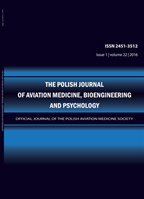2020, Volume 26, Issue 4
THE INCIDENCE OF SIMULATOR SICKNESS IN PILOTS AND NON-PILOTS EXPOSED TO SPATIAL DISORIENTATION EVENTS IN THE GYRO-IPT SIMULATOR
RAFAŁ LEWKOWICZ1, BIBIANNA BAŁAJ2, PIOTR FRANCUZ3
-------------------------------------------------------------------------------------------------
1Department of Simulator Studies and Aeromedical Training, Military Institute of Aviation Medicine
2Faculty of Philosophy and Social Sciences, Nicolaus Copernicus University
3Faculty of Social Sciences, Institute of Psychology, John Paul II Catholic University of Lublin
Autor korenspondencyjny: RAFAŁ LEWKOWICZ; Department of Simulator Studies and Aeromedical Training, Military Institute of Aviation Medicine; email: rlewkowicz@wiml.waw.pl
Full text
Streszczenie
Introduction: A previous study conducted in the Gyro-IPT simulator revealed that applied flight scenarios induced minor severity of simulator sickness symptoms in participants. In this study, however, we did not investigate how the severity of symptoms differs between pilots and non-pilots. Therefore, the presented study aimed to examine whether the symptoms of simulator sickness induced in pilots and non-pilots during spatial disorientation (SD) training are significantly different. We were particularly interested in whether the standard flight scenario used in SD training could be a contributing factor in increasing simulator sickness in novice, inexperienced pilots.
Method: We used the data from the previous study, where twenty male military pilots (age 31.6 ±8.22) with flight experience (total flight hours 1300 ±1167.4) and 20 non-pilots (age 30.9 ±7.72) were assigned to one of two groups and then exposed to a 1-hour long flight session (12 flight profiles, six involved an SD-conflict) with active control in the Gyro IPT simulator. To measure simulator sickness symptoms, the Simulator Sickness Questionnaire (SSQ) was administered pre and post-simulator exposure. In the presented study, the SSQ scores were analyzed independently for the total SSQ and subscores for nausea, oculomotor, and disorientation, and then were compared between groups.
Results: The score of the total severity and for each subscale of SSQ symptoms in the non-pilots‘ group were higher than those in the pilots group, however, these differences were not significant. Despite the observed differences, according to the SSQ scoring criteria the simulator sickness symptoms reported by the participants after exposure to the applied flight scenario were negligible.
Conclusion: The flight scenarios used in SD training did not generate significantly different symptoms of simulator sickness between non-pilots and pilots. The low level of severity of simulator sickness symptoms in these two study groups may indicate difficulty in predicting simulator sickness based on SSQ only.
Słowa kluczowe
simulator sickness, motion sickness, flight simulator, spatial disorientation, expertise
